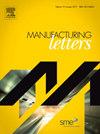在非笛卡尔坐标系中为柔性系统生成限位连续刀具路径
IF 1.9
Q3 ENGINEERING, MANUFACTURING
引用次数: 0
摘要
受计算机数控(CNC)技术以及电子和微控制器领域急剧变化的启发,在数控机床上使用非笛卡尔坐标系的想法成为人们感兴趣的话题。非笛卡尔坐标系为具有较大工作空间的系统提供了运动自由度,在这种情况下,高尺寸精度并不是首要考虑因素。此类系统的应用可以在壁画中找到,即在任意材料的大墙上绘制一幅画。本文介绍了一种新的设计,用于在大型表面上自动绘制壁画。所提出的机构利用链条和链轮来克服传统 X-Y 工作台的尺寸限制。此外,所开发的机构没有使用传统数控系统中常见的坚固结构,而是使用没有严重约束的柔性臂来实现工具运动。利用连续轨迹和运动曲线消除了系统不必要的振动影响。为提高绘制复杂曲线的灵活性,采用了用于轨迹规划的参数曲线插值算法。采用 B-样条曲线和非均匀有理 B-样条曲线(NURBS)等参数曲线来生成用于运动控制和运动曲线提取的运动受限轨迹。这种轨迹限制了系统的颠簸,并保证了平稳的运动,不受进给率波动的影响。与其他提取运动学轮廓的方法相比,限制运动的方法减少了移动时间和轨迹误差。最终,通过使用运动曲线和二阶泰勒插值器生成了运动指令。STM32746ZG 卡被用作主处理器,两个由比特模式插值算法控制的步进电机被用来驱动拟议的机构。步进电机的输入脉冲被存储为二进制位,并实时传输给驱动器。此外,还通过安装在电机轴端部的两个旋转编码器对反馈进行评估。编码器数据通过 TCP/IP 协议获取和传输,以保证在传输过程中不会丢失数据。本文章由计算机程序翻译,如有差异,请以英文原文为准。
Jerk limited continuous tool path generation for flexible systems in non-cartesian coordinate systems
Inspired by computer numerical control (CNC) technology and drastic changes in the world of electronics and microcontrollers, the idea of using non-cartesian coordinate system for CNC machines became a topic of interest. Non-cartesian coordinate systems provide freedom of movement in systems with large working spaces where high dimensional accuracy is not a prime concern. Applications of such systems can be found in murals, where a painting is applied to a large wall of any arbitrary build material. In the present paper, a new design was introduced to automate the process of drawing murals on large surfaces. The proposed mechanism utilized chain and sprocket to overcome the size limitations of traditionally available x-y tables. In addition to that, the developed mechanism does not utilize the common robust structures used in the conventional CNC systems and the tool motion is created using flexible arms that are not heavily constrained. The effect of systems unwanted vibration has been eliminated using continuous trajectory and kinematic profiles. Parametric curve interpolation algorithms for trajectory planning were implemented to increase the flexibility of drawing complex curves. Parametric curves such as B-spline and non-uniform rational B-spline (NURBS) were employed to generate a jerk limited trajectory for motion control and extraction of kinematic profiles. Such trajectory constrains the jerk of the system and guarantees a smooth motion free of feed-rate fluctuations. Compared to other methods available for extracting the kinematic profiles, jerk limited method decreases the travel time and trajectory error. Ultimately, motion commands were produced by using kinematic profiles and the second order Taylor interpolator. STM32746ZG card was used as the main processor and two stepper motors controlled by a Bit Pattern interpolation algorithm were utilized to drive the proposed mechanism. The input pulses of stepper motors were stored as binary bits and transmitted to drivers in real-time. The feedback was also evaluated by two rotary encoders, placed at the end of the motors’ shafts. Encoder data were acquired and transmitted using a TCP/IP protocol to guarantee zero data loss during the transmission.
求助全文
通过发布文献求助,成功后即可免费获取论文全文。
去求助
来源期刊

Manufacturing Letters
Engineering-Industrial and Manufacturing Engineering
CiteScore
4.20
自引率
5.10%
发文量
192
审稿时长
60 days
 求助内容:
求助内容: 应助结果提醒方式:
应助结果提醒方式:


